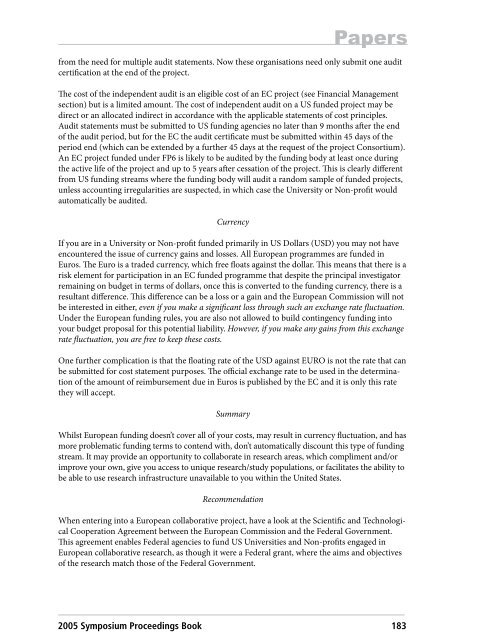The SRA Symposium - College of Medicine
The SRA Symposium - College of Medicine
The SRA Symposium - College of Medicine
Create successful ePaper yourself
Turn your PDF publications into a flip-book with our unique Google optimized e-Paper software.
from the need for multiple audit statements. Now these organisations need only submit one audit<br />
certification at the end <strong>of</strong> the project.<br />
<strong>The</strong> cost <strong>of</strong> the independent audit is an eligible cost <strong>of</strong> an EC project (see Financial Management<br />
section) but is a limited amount. <strong>The</strong> cost <strong>of</strong> independent audit on a US funded project may be<br />
direct or an allocated indirect in accordance with the applicable statements <strong>of</strong> cost principles.<br />
Audit statements must be submitted to US funding agencies no later than 9 months after the end<br />
<strong>of</strong> the audit period, but for the EC the audit certificate must be submitted within 45 days <strong>of</strong> the<br />
period end (which can be extended by a further 45 days at the request <strong>of</strong> the project Consortium).<br />
An EC project funded under FP6 is likely to be audited by the funding body at least once during<br />
the active life <strong>of</strong> the project and up to 5 years after cessation <strong>of</strong> the project. This is clearly different<br />
from US funding streams where the funding body will audit a random sample <strong>of</strong> funded projects,<br />
unless accounting irregularities are suspected, in which case the University or Non-pr<strong>of</strong>it would<br />
automatically be audited.<br />
Currency<br />
If you are in a University or Non-pr<strong>of</strong>it funded primarily in US Dollars (USD) you may not have<br />
encountered the issue <strong>of</strong> currency gains and losses. All European programmes are funded in<br />
Euros. <strong>The</strong> Euro is a traded currency, which free floats against the dollar. This means that there is a<br />
risk element for participation in an EC funded programme that despite the principal investigator<br />
remaining on budget in terms <strong>of</strong> dollars, once this is converted to the funding currency, there is a<br />
resultant difference. This difference can be a loss or a gain and the European Commission will not<br />
be interested in either, even if you make a significant loss through such an exchange rate fluctuation.<br />
Under the European funding rules, you are also not allowed to build contingency funding into<br />
your budget proposal for this potential liability. However, if you make any gains from this exchange<br />
rate fluctuation, you are free to keep these costs.<br />
One further complication is that the floating rate <strong>of</strong> the USD against EURO is not the rate that can<br />
be submitted for cost statement purposes. <strong>The</strong> <strong>of</strong>ficial exchange rate to be used in the determination<br />
<strong>of</strong> the amount <strong>of</strong> reimbursement due in Euros is published by the EC and it is only this rate<br />
they will accept.<br />
Summary<br />
Whilst European funding doesn’t cover all <strong>of</strong> your costs, may result in currency fluctuation, and has<br />
more problematic funding terms to contend with, don’t automatically discount this type <strong>of</strong> funding<br />
stream. It may provide an opportunity to collaborate in research areas, which compliment and/or<br />
improve your own, give you access to unique research/study populations, or facilitates the ability to<br />
be able to use research infrastructure unavailable to you within the United States.<br />
Recommendation<br />
Papers<br />
When entering into a European collaborative project, have a look at the Scientific and Technological<br />
Cooperation Agreement between the European Commission and the Federal Government.<br />
This agreement enables Federal agencies to fund US Universities and Non-pr<strong>of</strong>its engaged in<br />
European collaborative research, as though it were a Federal grant, where the aims and objectives<br />
<strong>of</strong> the research match those <strong>of</strong> the Federal Government.<br />
2005 <strong>Symposium</strong> Proceedings Book 183

















